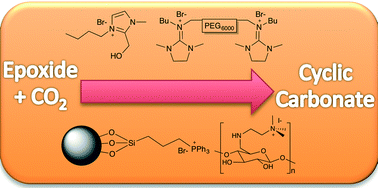Synthesis of cyclic carbonates from CO2 and epoxides using ionic liquids and related catalysts including choline chloride–metal halide mixtures†‡§
Abstract
In this mini-review, progress made in the use of ionic liquid catalysts and related systems for cycloaddition reactions of carbon dioxide with epoxides is described with the primary focus on results from the past eight years. Catalysts described range from simple onium species including tetrabutylammonium bromide, functionalized and simple imidazolium ionic liquids, to a plethora of supported ionic liquid systems. A range of supports including alumina, silica, carbon nanotubes, magnetic nanoparticles, poly(ethyleneglycol), polystyrene, cellulose and chitosan have been used with a variety of ionic groups. These include ammonium, phosphonium and both functionalized and unfunctionalized imidazolium salts. Results have been tabulated to summarize reaction conditions and TONs for styrene oxide, propylene oxide and cyclohexene oxide conversions. It is clear that metal ions used in combination with ionic liquids, particularly ZnBr2, can enhance conversions, and hydroxyl, carboxyl and other functional groups capable of hydrogen-bonding can be incorporated to improve catalysis. Some recent results using flow reactors are highlighted. Examples of ionic catalysts used in the related processes of oxidative carboxylation of alkenes, which also yields cyclic carbonate products, and carbon dioxide–aziridine coupling reactions, which yield oxazolidinone products are described. New data on catalytic styrene carbonate production using choline chloride-transition metal chloride mixtures are presented. For 3d metals, the catalytic activity of these mixtures is Cr > Co ≈ Fe ≈ Ni > Mn ≫ Cu.

- This article is part of the themed collection: Carbon dioxide conversion

 Please wait while we load your content...
Please wait while we load your content...